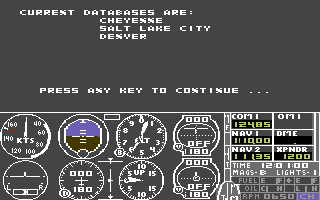Retro Replay Review
Gameplay
Scenery Disk 5 seamlessly integrates with subLOGIC’s Flight Simulator II and a range of other flight simulation titles, breathing new life into familiar digital skies. Installation is straightforward: simply load the disk’s data files into your simulator’s scenery directory and activate the region in your flight plan menu. Within minutes, pilots can chart a course over Salt Lake City, Cheyenne, or Denver and immediately notice airport outlines, taxiways, and VOR beacons positioned precisely where real-world pilots expect them to be.
(HEY YOU!! We hope you enjoy! We try not to run ads. So basically, this is a very expensive hobby running this site. Please consider joining us for updates, forums, and more. Network w/ us to make some cash or friends while retro gaming, and you can win some free retro games for posting. Okay, carry on 👍)
Whether you’re flying a bush plane into Logan or lining up for an ILS approach into Colorado Springs, the added navigational aids enhance your preflight briefing and in-flight decision-making. Disk 5 provides detailed radio frequencies, navaids, and waypoint markers derived directly from NOAA Sectional Aeronautical Charts and Airport/Facility Directories. As a result, cross-country flights feel more authentic: you’ll use real VOR radials to intercept airways and monitor DME readings as you descend toward mountainous terrain.
This add-on also encourages exploration. Venture off established airways to scout the rugged topography around Aspen and Pueblo, or challenge yourself with short-field operations at Douglas. The array of airports—from the regional hub in Boise to the less-frequented strip at Fairfield—offers varying levels of complexity, making this pack suitable for both novice virtual pilots and seasoned flight sim veterans seeking a fresh regional challenge.
Graphics
Scenery Disk 5 showcases a notable leap in visual fidelity for early-era flight simulators. Terrain elevations are represented with contour accuracy, so the Wasatch Range north of Salt Lake City undulates realistically beneath your wings. Textured overlays depict farmland patchworks, urban sprawl, and vast desert basins; these ground textures are derived from high-resolution NOAA charts, giving your simulated cockpit view an almost cartographic precision.
Airports receive special attention: runway markings are crisp and proportionally accurate, while taxiway layouts match official airport diagrams. Whether you’re lining up on Runway 35 at Boise or taxiing to the terminal at Rapid City, the pavement geometry and lighting cues guide your movements just as they would in real life. Landmark features—such as the Utah State Capitol building, Cheyenne’s historic depot, and Denver’s mile-high skyline—are modeled with distinguishable shapes and placed in correct relative positions to each airfield.
Despite the era’s hardware limitations, performance remains smooth. Frame rates hold steady even when flying low over Denver’s clustered suburbs. The add-on strikes a careful balance between graphical detail and computational efficiency, ensuring that vintage machines or modest modern setups can render the expanded regions without stuttering.
Story
While Scenery Disk 5 is fundamentally a technical enhancement, it weaves its own narrative tapestry by connecting you to America’s Intermountain West. As you take off from Salt Lake City, you sense the pioneering spirit that forged these high plains and snow-capped ranges. Each flight becomes a journey through aviation history, retracing routes once blazed by early airmail pilots and mountain surveyors.
Plotting a cross-country hop from Denver to Cheyenne unfolds like a short adventure: you depart the bustling urban terminal, roar over the Pawnee National Grassland, and touch down on wind-swept runways where cattle ranches stretch to the horizon. The regional storyline emerges from waypoints named in local lore—Pueblo’s steelworks, Boulder’s foothills, or Aspen’s alpine valleys—inviting you to craft your own missions, whether it’s a sightseeing tour or a mercy flight through a virtual winter storm.
Beyond individual flights, the add-on fosters a community narrative. Enthusiasts share custom flight plans, vintage navigation logs, and real-world photos to compare how closely the simulator’s rendition matches reality. Disk 5 thus becomes more than scenery: it’s a launching pad for pilot stories and shared exploration, deepening your connection to each virtual dispatch.
Overall Experience
Scenery Disk 5 stands out as a landmark expansion for flight sim aficionados who crave authenticity without sacrificing performance. The combination of detailed airports, accurate navigational aids, and topographically faithful terrain transforms routine flights into immersive missions. Long-time simmers will appreciate the disk’s fidelity to NOAA data, while newcomers benefit from the structured approach to region activation and flight planning.
Over dozens of hours logged in Flight Simulator II and Microsoft Flight Simulator 2.x, the disk’s enhancements never grow stale. Exploring Boise’s river canyon approaches, navigating mountain passes around Aspen, or conducting night operations into Colorado Springs all feel distinct thanks to the bespoke scenery and realistic airport placements. The frictionless integration means you spend more time flying and less time troubleshooting compatibility issues.
For pilots building a continental US scenery collection—perhaps to eventually encompass all 12 standard disks—Disk 5 is an indispensable chapter. It strikes an ideal balance between breadth of coverage and detail density, delivering a richly varied flying environment. Whether you’re dispatching cargo, running passenger services, or simply sightseeing, Scenery Disk 5 elevates your flight simulator into a living map of the American West.
 Retro Replay Retro Replay gaming reviews, news, emulation, geek stuff and more!
Retro Replay Retro Replay gaming reviews, news, emulation, geek stuff and more!





Reviews
There are no reviews yet.